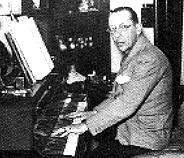It is a musician more fertile than Fauré, and it also innovates with exceptional sonorities, a complex
rhythm, and refined harmonies.
.
Maurice Ravel (1875-1937) works the composition with Fauré with the academy in 1889. After having obtained the second Price of the contest of Rome, it is made exclude and cannot represent it.
Its life proceeds without big events, very devoted to Article Its works, the beginning of its career, are completed perfectly, and of a rare
smoothness.
It will compose of works for piano, of the chamber music, the melodies, and the symphonic music, two concertos for piano, including one for the left hand alone.
Paul Dukas (1865-1935) obtains the second price of Rome in 1888. One will retain the symphony in C (1896) and the Sorcerer's apprentice (1897)
In 1912 there ceases composing and remains almost quiet until its death. In margin of the
composers quoted above Erik Satie is. It has the appearance of a recluse, seeking to break with the emphase and the gigantism of symphonic works.
Its stripped style, with its melody lines and its simple
rhythms, locates it at cross several esthetics and will inspire the Group of the Six, including three principal members testify to a very marked personality:
.
Darius Milhaud (1892-1974), author of a catalogue of more than 400 works, makes a broad use of the polytonality which will scandalize the public of the
Twenties;
Arthur Honegger (1892-1955), marked by its Germanic Swiss origins, composes a serious and lyric music, with the innate architectural direction;
Francis Poulenc (1899-1963), the most popular musician of the Six, built its music in the prolongation of the tonal tradition, but each one of its works testifies to an immediately recognizable and tempting personality and a style.
.
The school of
Vienna.
.
With dimensions Germanic one, Schoenberg (1874-1951) seems the father of the dodecaphonic music,
(dodéca = twelve in Greek) i.e. the twelve sounds, and of the serial music which abolishes any hierarchy between the notes and the concept of tonality. In 1912 it composes the “Lunar Pierrot” which will make it famous.
Alban Berg (1885-1935) was the pupil of Schoenberg, then his friend.
In 1924 it composes Wozzeck which will be often represented until the advent of the Nazism.
In 1935 it composes the concerto for violin “Concerto with the memory of an angel”, it will be its last work.
Anton Webern (1883-1945) is also the pupil of Schoenberg in 1904. Its first works still carry the traces of the Mahlerien style.
Disciple of Schoenberg, at his beginnings, it will dissociate himself from the Master to impose his own artistic thought, his own musical
writing.
It is with the Russians that I will conclude this chapter on the new music.
.
 Stravinsky
StravinskyThe bird of fire of
Stravinsky  Uniquement sur le Cd-Rom
du site
Uniquement sur le Cd-Rom
du site
Stravinsky, (1882-1971) becomes famous while collaborating, in Paris, with the Ballets of Diaghilev: the Bird of fire (1910), the Rite of Spring (1913).
These two works revolutionize the music. News under all their aspects, especially with regard to the
rhythm and the harmony, they remains however enracinées in the Russian tradition. In 1923 it starts to explore a new musical esthetics:
Always in the search of new forms, it comes, towards the end of its life, to the dodecaphonic technique of Schönberg and Webern, which it had hitherto pushed back.
.
Finale of the fifth Symphony  Uniquement sur le Cd-Rom
du site
Uniquement sur le Cd-Rom
du site
.
Chostakovitch, (1906-1975), is the principal Russian composer of the medium of XXme century. With its Symphony n° 1 (1926) he is noticed abroad.
Its music is characterized by vitality from the rhythm and the melody
richness. Its first two operas, were well accomodated, but censured by the communist capacity which considered them middle-class and
declining.
The Symphony n° 5 (1937), accepted a favorable reception. In 1948, its music was again attacked for political reasons, which led it to re-examine its musical style. It reached that point, since it accepted the Order of Lénine, several times the Stalin price and in 1966. He was the first composer to receive the title of Hero of socialist work.
Among its works appear six concertos, fifteen symphonies, of the ballet music, and the film musics. Its production, can be regarded as an important contribution with the tonal music, at one time when its contemporaries turned to the serialism or the neoclassicism.
Its symphonies, are in the line line of Gustav Mahler.
|
|
|
|